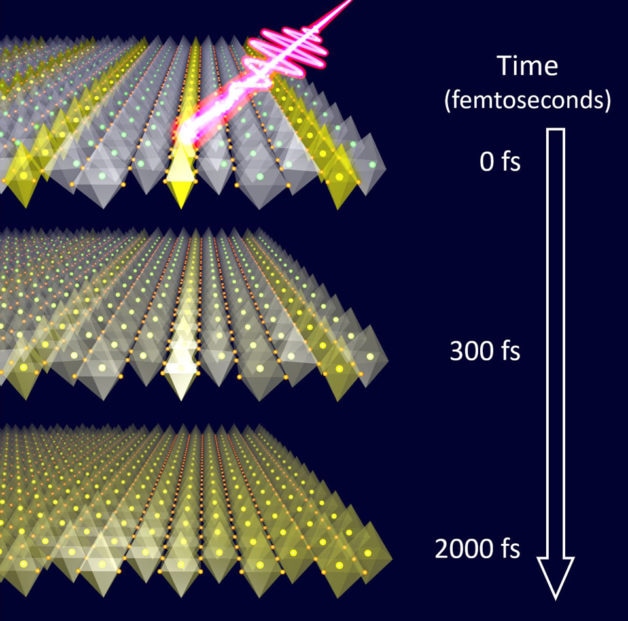Nov 30 2017
Stripes are present everywhere, from the latest fashion statement to zebras roaming in the wild. Periodic stripe patterns can be developed by electrons within quantum materials in the world of microscopic physics.
 Illustration of an ultrashort laser light striking a lanthanum strontium nickel oxide crystal, triggering the melting of atomic-scale stripes. The charges (yellow) quickly become mobile while the crystal distortions react only with delay, exposing the underlying interactions. (Credit: Robert Kaindl/Berkeley Lab)
Illustration of an ultrashort laser light striking a lanthanum strontium nickel oxide crystal, triggering the melting of atomic-scale stripes. The charges (yellow) quickly become mobile while the crystal distortions react only with delay, exposing the underlying interactions. (Credit: Robert Kaindl/Berkeley Lab)
Scientists at the Department of Energy’s Lawrence Berkeley National Laboratory (Berkeley Lab) have recently unraveled the fascinating dynamics of how such atomic-scale stripes melt and then form, providing essential insights that could be useful for developing novel energy materials.
Interactions between the electrons reign supreme in strongly correlated quantum materials. The complex coupling of these electrons with each other – and with crystal vibrations and electron spins – results in interesting phases such as high-temperature superconductivity or charge ordering.
A key goal of condensed matter physics is to understand the forces responsible for complex phases and the transitions between them, but in the microscopic world, interactions are often extremely fast. If we just slowly heat or cool a material to change its phase, we can miss out on the underlying action.
Robert Kaindl, a principal investigator, staff scientist, Berkeley Lab’s Materials Sciences Division.
Kaindl and his colleagues have been employing ultrafast laser pulses in order to tease apart the microscopic dynamics of correlated quantum materials, thus accessing the interactions with the crystal’s atomic lattice and among the electrons in the time domain.
The researchers, for this study, worked with lanthanum nickelate, which is a quantum material and model stripe compound. They specifically investigated the electronic charges that produce the stripe pattern and also learnt how they couple to the crystal lattice.
The researchers stated that the manner in which the charges interact with the crystal is considered to be a vital ingredient to stripe physics.
“The crystal lattice strongly distorts around the charge stripes,” said Giacomo Coslovich, who carried out the work while he was a postdoctoral researcher at Berkeley Lab. “This change of the crystal symmetry results in new lattice vibrations, which we can in turn detect with light at terahertz frequencies.”
Kaindl and Coslovich are corresponding authors of a paper that reports these results in Science Advances.
In the experiments carried out by these researchers, the material is optically excited by a near-infrared laser pulse for 50 femtoseconds, and it is then probed with a terahertz pulse with variable time delay. A femtosecond is one millionth of one billionth of a second.
The researchers discovered unexpected dynamics when they used the laser to upset the microscopic order.
“The interesting thing is that while the laser immediately excited the electrons, the vibrational distortions in the crystal initially remained frozen,” said Coslovich, who is now associate staff scientist at SLAC National Accelerator Laboratory. “The stripe-phase vibrations disappeared only after several hundred to a few thousand femtoseconds. We also concluded that the speed depends on the direction of the interactions.”
Simulations of the phonon dispersion by Alexander Kemper of North Carolina State University helped support the interpretation of the experiments.
The results offer vital insight into the interactions, or “glue,” that is responsible for coupling electrons to lattice vibrations in the lanthanum nickelate. However, their wider relevance stems from latest observations of charge order in high-temperature superconductors, which are materials where electrical currents can pass without resistance at temperatures above the boiling point of liquid nitrogen. Recent studies have demonstrated the potential to induce superconductivity by suppressing stripes with short light pulses even while the mechanism remains puzzling.
“Fluctuating stripes are thought to occur in unconventional superconductors. Our study puts a speed limit on how fast such patterns can change,” said Kaindl. “It highlights the importance of considering both the spatial and temporal structure of the glue.”
The DOE Office of Science supported this work. Berkeley Lab’s Advanced Light Source, a DOE Office of Science User Facility, was used for characterizing the material’s equilibrium optical properties.